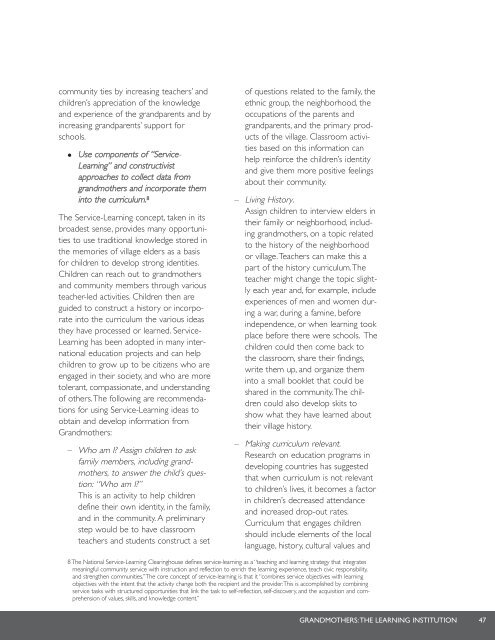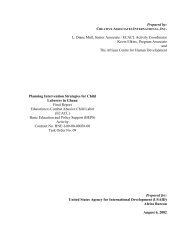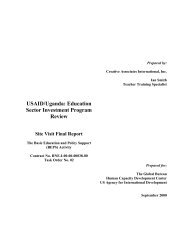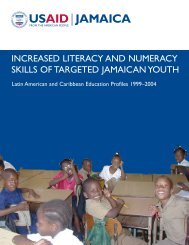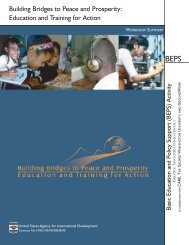Grandmothers: A Learning Institution - Basic Education and Policy ...
Grandmothers: A Learning Institution - Basic Education and Policy ...
Grandmothers: A Learning Institution - Basic Education and Policy ...
- No tags were found...
You also want an ePaper? Increase the reach of your titles
YUMPU automatically turns print PDFs into web optimized ePapers that Google loves.
community ties by increasing teachers’ <strong>and</strong>children’s appreciation of the knowledge<strong>and</strong> experience of the gr<strong>and</strong>parents <strong>and</strong> byincreasing gr<strong>and</strong>parents’ support forschools.• Use components of “Service-<strong>Learning</strong>” <strong>and</strong> constructivistapproaches to collect data fromgr<strong>and</strong>mothers <strong>and</strong> incorporate theminto the curriculum. 8The Service-<strong>Learning</strong> concept, taken in itsbroadest sense, provides many opportunitiesto use traditional knowledge stored inthe memories of village elders as a basisfor children to develop strong identities.Children can reach out to gr<strong>and</strong>mothers<strong>and</strong> community members through variousteacher-led activities. Children then areguided to construct a history or incorporateinto the curriculum the various ideasthey have processed or learned. Service-<strong>Learning</strong> has been adopted in many internationaleducation projects <strong>and</strong> can helpchildren to grow up to be citizens who areengaged in their society, <strong>and</strong> who are moretolerant, compassionate, <strong>and</strong> underst<strong>and</strong>ingof others.The following are recommendationsfor using Service-<strong>Learning</strong> ideas toobtain <strong>and</strong> develop information from<strong>Gr<strong>and</strong>mothers</strong>:– Who am I? Assign children to askfamily members, including gr<strong>and</strong>mothers,to answer the child’s question:“Who am I?”This is an activity to help childrendefine their own identity, in the family,<strong>and</strong> in the community. A preliminarystep would be to have classroomteachers <strong>and</strong> students construct a setof questions related to the family, theethnic group, the neighborhood, theoccupations of the parents <strong>and</strong>gr<strong>and</strong>parents, <strong>and</strong> the primary productsof the village. Classroom activitiesbased on this information canhelp reinforce the children’s identity<strong>and</strong> give them more positive feelingsabout their community.– Living History.Assign children to interview elders intheir family or neighborhood, includinggr<strong>and</strong>mothers, on a topic relatedto the history of the neighborhoodor village.Teachers can make this apart of the history curriculum.Theteacher might change the topic slightlyeach year <strong>and</strong>, for example, includeexperiences of men <strong>and</strong> women duringa war, during a famine, beforeindependence, or when learning tookplace before there were schools. Thechildren could then come back tothe classroom, share their findings,write them up, <strong>and</strong> organize theminto a small booklet that could beshared in the community.The childrencould also develop skits toshow what they have learned abouttheir village history.– Making curriculum relevant.Research on education programs indeveloping countries has suggestedthat when curriculum is not relevantto children’s lives, it becomes a factorin children’s decreased attendance<strong>and</strong> increased drop-out rates.Curriculum that engages childrenshould include elements of the locallanguage, history, cultural values <strong>and</strong>8 The National Service-<strong>Learning</strong> Clearinghouse defines service-learning as a “teaching <strong>and</strong> learning strategy that integratesmeaningful community service with instruction <strong>and</strong> reflection to enrich the learning experience, teach civic responsibility,<strong>and</strong> strengthen communities.”The core concept of service-learning is that it “combines service objectives with learningobjectives with the intent that the activity change both the recipient <strong>and</strong> the provider.This is accomplished by combiningservice tasks with structured opportunities that link the task to self-reflection, self-discovery, <strong>and</strong> the acquisition <strong>and</strong> comprehensionof values, skills, <strong>and</strong> knowledge content.”GRANDMOTHERS:THE LEARNING INSTITUTION47


